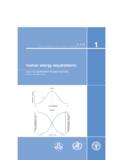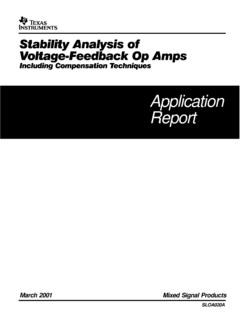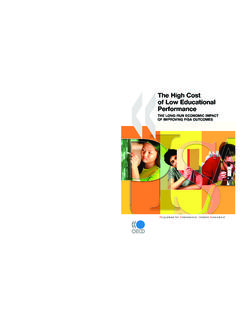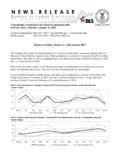Transcription of Economic Case for Eradicating Polio
1 Economic Case for Eradicating Polio Summary The Polio Eradication and Endgame Strategic Plan 2013- 2018 (The Plan)1 has been developed to capitalize on a unique opportunity to eradicate a disease only the second time in history. The ambitious Plan will cost $ billion to implement and require additional resources from In the current fiscal climate of scarcity, it is important to examine the Economic case for continuing to invest in Polio eradication. As recently as the 1980s, Polio crippled an estimated 350,000 children every So far, the Global Polio Eradication Initiative (GPEI) has ensured that millions of people are now walking who would have been paralyzed. The disease remains endemic in only three countries . Afghanistan, Nigeria, and Pakistan, and fewer than 250. children were paralyzed in 2012. The investment of $9. billion since GPEI's initiation in 19884 has been critical to this success.
2 It has already generated net benefits of $27 billion , out of the total $40-50 billion previously Building on an existing body of work,6 this report offers a forward-looking perspective on the benefits of eradication using updated cost inputs that underlie the It establishes three core Economic arguments for continuing to invest in Polio eradication: 1. Eradication is more cost-effective than the alternatives presented;. 2. GPEI's commitment to strengthen immunization systems and support other health priorities will bring additional Economic benefits;. 3. GPEI is carefully managing its resources and making efforts to be more efficient. 1. For the latest Polio Eradication Endgame and Strategic Plan please visit 2. Cost of eradication has several components: GPEI funding, in-country spend on eradication and ongoing spend on Polio vaccines through the routine immunization system 3.
3 In 1988, prior to the start of GPEI, annual Polio incidence was estimated to 350,000 or more. See also WHO's factsheet on Polio at 4. $9 billion investment includes funding to GPEI in 104 countries, excludes in-country eradication spend, unless part of the GPEI financial resources requirements 5. Duintjer Tebbens RJ, Pallansch MA, Cochi SL, Wassilak SGF, Linkins J, Sutter RW, Aylward RB, Thompson KM. Economic analysis of the Global Polio Eradication Initiative. Vaccine 2011;29(2):334-343. This study estimated total net benefits of $40-50 billion for the 104 countries that benefit from the GPEI over the period of 1988-2035, with an additional $17 billion or more arising from delivering Vitamin A as part of Polio vaccine campaigns. 6. See note 5 and Thompson KM, Duintjer Tebbens RJ. Eradication versus control for poliomyelitis: An Economic analysis.
4 The Lancet 2007;369 (9570):1363-71. This prospective Economic analysis of eradication versus control demonstrated that pursuing a policy of control in perpetuity implied greater health and financial costs than eradication. 7. Reflects the current Plan and up-to-date estimates for key costs such as product prices, cost of immunization, required surveillance and outbreak control. The primary focus of this analysis is the 38 countries that receive the vast majority of GPEI funds. 2 Summary | 1 | 2 | 3 | Conclusion To evaluate the first core argument, the costs and benefits Compared to the alternatives considered, Eradicating of eradication were compared to viable alternatives Polio is the most cost-effective choice based on over a period of Two alternatives to eradication the benefits from Eradicating Polio alone. Even with were considered: relying solely on the existing routine an additional $ billion invested, and continued immunization (RI) infrastructure, and a control policy aimed investment by countries, the Plan promises to yield up at keeping the number of Polio cases below a certain to $25 billion in additional net benefits over the next annual level.
5 Consistent with past research, 9 relying on 20 years. These benefits apply to the 38 countries that are current levels of routine immunization would lead to a the core beneficiaries of GPEI funding10 and do not take into rapid resurgence of Polio cases and result in hundreds of account the additional benefits possible over a longer time thousands of paralyzed children annually within a number of period globally. years. Pursuing a strategy of control may be less expensive than eradication in the next few years, but the cumulative The second core argument demonstrates the potential costs of this approach over time (operational costs, but benefits GPEI will bring to other health programs. In the also productivity losses and treatment costs) would quickly past, these contributions were largely opportunistic. overtake the costs of eradication, as shown in Exhibit 1.
6 From 1988 to 2010, it is estimated that GPEI workers administered up to billion doses of Vitamin A during Polio campaigns, averting at least million deaths and creating an Economic benefit of at least $17 For the first time, strengthening immunization systems and Exhibit 1 legacy planning are included as integral components of Control has lower costs in the first few years, but the the Plan, and these contributions will generate additional cumulative costs quickly overtake those of eradication Economic benefits. In particular, the Plan sets explicit targets to increase immunization coverage in the 10 countries most affected by Polio . In Nigeria alone this could prevent ~30- 35,000 deaths between 2014 and 2018 and result in an Economic benefit of ~$4 The third core argument is that GPEI has taken an active Annual costs approach to resource management to maximize efficiency and ensure the donors' investments are well-spent.
7 This Control includes working with partners to manage costs for Oral Polio Vaccine (OPV) and Inactivated Polio Vaccine (IPV), improving operational efficiency, and securing advance funding. Eradication While the Economic benefits of investing in eradication are clear, experience has shown that gains in the battle against Polio are precarious. Until eradication is completed, the 2013 2017 2021 2025 2029 2033 world remains at risk of the disease reemerging, resulting in Years tragic, avoidable health outcomes as well as the potential for increased costs. Eradication will require a concerted, Source : Team Analysis, GPEI Plan focused effort, along with full investment in the Plan. 8. See Thompson and Duintjer Tebbens 2007, note 5. 9. See notes 5 and 6. 10. Estimated benefits are to the 38 countries receiving technical assistance and supplemental funding from GPEI (majority of GPEI funding) Does not include the potential benefits to other countries covered by GPEI who receive only smaller amounts of funding.
8 11. See Duintjer Tebbens et al. 2011, note 5. 12. Deaths averted from increased immunization calculated based on ratio of deaths averted per 1,000 children immunized. Economic benefits based on averted productivity losses. For more details see section 2 and technical appendix Summary | 1 | 2 | 3 | Conclusion 3. 1. Polio eradication is the most cost-effective option To compare eradication to other scenarios, the study Even the most aggressive assumptions on IPV use involve started by estimating the full costs of eradication and post- costs of no more than $500 million per year for the 38. eradication activities. The costs of GPEI will continue to countries in this analysis. As a result, total eradication and be substantial over the next six years until wild poliovirus post-eradication costs amount to an estimated $10-16. transmission is interrupted and certification is completed.
9 billion over 20 years (2013-2033). GPEI plans for countries to stop using OPV by 2019, leading to a significant drop in costs. However, countries will This study considers two alternatives to the eradication need to continue immunization with IPV for at least several scenarios: more years. There is significant uncertainty surrounding the exact policies countries will pursue after they stop 1. Halting GPEI and relying upon the existing routine using OPV. Three different post-eradication scenarios were immunization system, and considered: 2. Implementing a control scenario that establishes a 1. Minimum IPV use assuming only one dose per child for maximum number of cases and then adjusts the 5 years post OPV cessation; intensity of campaigns to try and stay below that number. 2. Ongoing IPV use with one dose per child;. 3. Ongoing IPV use with three doses per child.
10 Exhibit 2. Routine immunization and control would lead to a rapid resurgence of Polio cases Operational Costs 2,000 paralyzed Economic benefit of as % of 2013 children eradication2. eradication costs1 Annual number of children paralyzed1 ($B, 2013-2033). Routine Immunization ~10% ~200,000 $18-25. only Control ~45% ~50,000 $6-25. 1. Relative to 2013 GPEI budget. Note that GPEI costs are not constant and decrease significantly during 2013-2018. Control costs remain stagnant. 2. Discounted at 3%, includes operational costs and costs of cases for control and eradication scenarios SOURCE: Team analysis, GPEI Plan 4 Summary | 1 | 2 | 3 | Conclusion Relying on routine immunization is the least expensive option in terms of operational costs. However, the current Exhibit 3. immunization infrastructure is insufficient to create enough All eradication scenarios are more cost effective than population immunity against the poliovirus in high-risk alternatives geographies.











